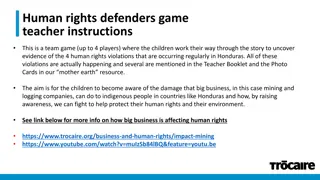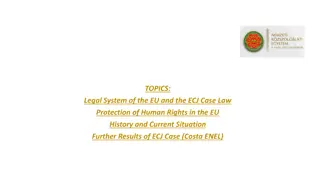Overview of Human Rights Monitoring Mechanisms
Human rights conventions under the United Nations and regional systems have established monitoring mechanisms to ensure compliance. These mechanisms include treaty-based and non-treaty-based approaches, with treaty bodies overseeing the implementation of legally binding instruments. Reporting procedures, inter-state and individual complaint processes, and inquiries are key components of these mechanisms, aimed at safeguarding human rights globally.
Download Presentation

Please find below an Image/Link to download the presentation.
The content on the website is provided AS IS for your information and personal use only. It may not be sold, licensed, or shared on other websites without obtaining consent from the author.If you encounter any issues during the download, it is possible that the publisher has removed the file from their server.
You are allowed to download the files provided on this website for personal or commercial use, subject to the condition that they are used lawfully. All files are the property of their respective owners.
The content on the website is provided AS IS for your information and personal use only. It may not be sold, licensed, or shared on other websites without obtaining consent from the author.
E N D
Presentation Transcript
HUMAN RIGHTS WEEK 9: PROTECT ON OF HR
Procedures numerous human rights conventions under the framework of the United Nations and the + regional systems in Africa, the Americas and Europe creation of a wide range of mechanisms for monitoring compliance with the standards agreed upon There are two distinctive types of supervisory mechanism: Treaty-based mechanism and Non- treaty- based mechanisms
Treaty-based mechanism (1) are supervisory mechanisms enshrined in legally binding human rights instruments or conventions Within the UN framework these mechanisms are often called treaty bodies , e.g. the Human Rights Committee and the Committee on the Rights of the Child. Regional: The African Commission and future Court on Human and Peoples Rights, the European Court and commission of Human Rights and the Inter-American Court and Commission of Human Rights are also treaty bodies.
Treaty-based mechanism (2) Each of these treaties has a supervisory body: These bodies consist of a number of experts of a high moral character and recognised competence in the field of human rights They act in their personal capacity, which means that although they are normally nationals of a state party to the treaty in question, they are not acting under instructions from respective governments The various supervisory procedures established in human rights treaties can be divided into four main groups: Reporting procedures Inter-state complaint procedure Individual complaint procedure Inquiries and other procedures
Reporting procedures (1) Most human rights treaties include a system of periodic reporting: States parties to them are obliged to report periodically to a supervisory body on the implementation at the domestic level of the treaty in question (Article 16 of ICESCR, Article 40 of ICCPR, Article 9 of CERD, Article 19 CAT, Article 44 of CRC, Article 18 of CEDAW and Article 73 of CMW) As formulated, e.g., in Article 40 of the ICCPR, States Parties shall submit reports on the measures they have adopted which give effect to the rights recognised herein and on the progress made in the enjoyment of those rights . At the UN level, each treaty body has formulated general guidelines regarding the form and contents of the reports to be submitted by States Parties as envisaged ( HRI/GEN/2/Rev.2) and their own rules of procedures (UN HRI/GEN/3/Rev.1).
Reporting procedures (2) The report is analysed by the relevant supervisory body, which comments on the report and may request the state concerned to furnish more information. In general, reporting procedures under the different treaty- based mechanisms are meant to facilitate and initiate a dialogue between the supervisory body and the State Party The quality of the reports submitted by states varies: Some reports are reliable and reflect serious efforts to comply with the reporting requirements, while others are lacking in credibility. In any case, the reports generally reflect the view of the respective state. In addition to the government report, the treaty bodies receive information on a country s human rights situation from other sources, including non-governmental organisations, UN agencies, other intergovernmental organisations, academic institutions, and the press
Inter-state-complaint procedure (1) Some human rights instruments allow states parties to initiate a procedure against another state party, which is considered not to be fulfilling its obligations under the instrument. In most cases, such a complaint may only be submitted if both the claimant and the defendant state have recognised the competence of the supervisory body to receive this type of complaint The possibility to lodge complaints against another state party is contemplated in, inter alia, Article 41 of ICCPR; Article 21 of CAT; Article 11 of CERD. In practice, inter-state complaint mechanisms are seldom used. Inter-state relationships are delicate and inter-state mechanisms may not be ideal procedures as states bringing complaints may elicit reprisals. In addition, many states have not recognised the competence of the supervisory bodies to receive inter-state complaints
Individual complaint procedure (1) It seems reasonable that individuals, on whose behalf human rights were stipulated in the first place, should be enabled to initiate proceedings to protect their rights. Such a procedure, whereby an individual holds a government directly accountable before an international supervisory body aims to afford far-reaching protection to the individual. In order for an individual to bring a case/communication/petition under a human rights convention, the following requirements have to be met: a) the alleged violating state must have ratified the convention invoked by the individual; b) the rights allegedly violated must be covered by the convention concerned; and c) proceedings before the relevant body may only be initiated after all domestic remedies have been exhausted
Individual complaint procedure (2) At the UN level, individual complaint mechanisms are found under five conventions: in the First Optional Protocol to the ICCPR; Article 22 of CAT; Optional Protocol to the CEDAW; Article 14 of CERD and Article 77 of CMW Individual complaints under one of the above-mentioned treaties can be brought only against a state that has recognised the competence of the committee established under the relevant treaty or become party to the relevant optional protocols Anyone under the jurisdiction of a state party can lodge a complaint with a committee against a state that satisfies this condition, claiming that his or her rights under the relevant treaty have been violated. There is no formal time limit after the date of the alleged violation for filing a complaint under the relevant treaties, but the victim should submit a complaint as soon as possible after having exhausted domestic remedies
Individual complaint procedure (3) While there are some procedural variations between the different UN treaties, their design and operation are very similar. In general terms, the system works as follows: 1. Once a complaint is submitted, the case is registered and transmitted to the state party concerned to give it an opportunity to comment. 2.The state is requested to submit its observations within a set time frame which varies between procedures. The two major stages in any case are known as the admissibility stage and the merits stage. The admissibility of a case refers to the formal requirements that the complaint must satisfy before the relevant committee can consider its substance. The merits of the case are the substance, on the basis of which the committee decides whether or not the rights under a treaty have been violated.
Individual complaint procedure (4) 3. Once the state replies to the complaint, the alleged victim is offered an opportunity to comment. Again, the time frames vary somewhat between procedures. 4. At this point, the case is ready for a decision by the relevant committee. If the state party fails to respond to the complaint the committee may take a decision on the case on the basis of the original complaint. There is no appeal against committees decisions. When a committee decides that the state party has violated a right, or rights, enshrined in the treaty, it invites the state party to supply information within a given time limit on the steps it has taken to give effect to the committee s findings
Inquiries and other procedures (1) The supervisory mechanisms now discussed includes all procedures that do not fall under those mentioned above. Most involve inquiries, but others may entail initiatives aimed at preventing violations or promoting compliance with specific human rights. The supervisory bodies discussed above play a rather passive role as they generally cannot initiate proceedings, and are largely dependent on information submitted by governments, or individual plaintiffs or petitioners
Inquiries and other procedures (2) Recently, however, several supervisory mechanisms have been established whereby an independent person or group of persons may raise, on the person s or group s own initiative, issues of non- compliance with human rights. Such a body may, for instance, act upon receipt of complaints or take an initiative itself. It may also initiate a visit in loco to gather information, or do so as part of a regular visit-programme. One example of a visit-programme - an enquiry and in loco visits procedure - is that set out in Articles 126 and 132 of the Third Geneva Convention (1949), and the provision in Article 143 of the Fourth Geneva Convention providing for on-site visits to places of internment or detention. Mention should also be made of the International Fact-Finding Commission established under Article 90 of Protocol I to the Geneva Conventions
Non-treaty- based mechanisms are supervisory mechanisms not based on legally binding human rights treaty obligations. Generally, this type of mechanism is based on the constitution or charter of an intergovernmental human rights forum, or on decisions taken by the assembly or a representative body of the forum in question. Under the UN framework, the non-treaty-based mechanisms are referred to as charter-based mechanisms, which include the 1503 procedure and the country mandates: International Court of Justice (ICJ) Security Council UN General Assembly Economic and Social Council UN Human Rights Council The European Commission against Racism and Intolerance under the Council of Europe is also an example of a regional non-treaty based mechanism
International Court of Justice (ICJ) (1) The International Court of Justice is the principal judicial organ of the United Nations. Its statute is an integral part of the charter of the United Nations and, consequently, all member states of the United Nations are ipso facto parties to the statue of the court. Only states may be parties in cases before the courts and the jurisdiction of the court will comprise all cases which the parties refer to it. In addition, states parties to the statute may at any time declare that they recognize the jurisdiction of the court in all legal disputes concerning: (a) the interpretation of a treaty; (b)any fact which, if established, would constitute a breach of an international obligation; and (c) the nature or extent of the reparation to be made for the breach of an international obligation
International Court of Justice (ICJ) (2) The General Assembly or the Security Council may request the court to give an advisory opinion on any legal question other organs of the United Nations and specialized agencies, which may at any time be so authorized by the General Assembly, may also request advisory opinions of the court on legal questions arising within the scope of their activities. A number of human rights instruments contain provisions where by any dispute between the contracting states relating to the interpretation, application or fulfillment of the instrument may be submitted to the Court at the request of any of the parties to the dispute. However, neither the ICCPR nor the ICESCR specifically provides for adjudication by the court
Security Council The Security Council may investigate any dispute, or any situation which might leads to international friction or give rise to a dispute, in order to determine whether the continuance of the dispute or situation is likely to endanger the maintenance of international peace and security. Any member of the United Nations may bring such dispute to the attention of the Security Council. When the Security Council determines the existence of any threat to the peace, breach of peace, or act of aggression, it may make recommendations, or decide what measures shall be taken to maintain or restore international peace and security measures which the security council may initially take include complete or partial interruption of economic relations and of rail, sea, air postal, telegraphic, radio, and other means of communication, and the severance of diplomatic relations. If such measures would be, or prove to be, inadequate, it may take such action by air, sea, or land forces as may be necessary to maintain or restore international peace and security. The Security Council has dealt with several human rights problems, including massive and repeated violations in South Africa, Somalia, Haiti, Yugoslavia, and Rwanda; the situation in the occupied Arab territories
United Nations General Assembly (1) One of the functions of the United Nations General Assembly is to intiate studies and make recommendations for the purpose of assisting in the realization of human rights and fundamental freedoms for all without distinction as to race, languages or religion The General Assembly has established a number of subsidiary organs which are concerned with human rights. These include; (a) The International Law Commission; whose object is the promotion of the progressive development of international law and its codification. Among the international human rights instruments it has prepared are the Genocide Convention, the Refugees Convention, the Conventions Relating to the Status of Stateless Persons and the Reduction of Statelessness, the Declaration on Territorial Asylum, and the Statute of the Office of the United Nations High Commissioner for Refugees.
United Nations General Assembly (2) (b) The Office of the United Nations High Commissioner for Refugees, which provides protection and assistance for refugees and other displaced persons. (c) The Special Committee on Declaration, or the Committee 24 , whose principal function is to monitor the implementation of the Declaration on the Granting Independence to Colonial Countries and Peoples. (d) Committee on the Exercise of the Inalienable Rights of the Palestinian People, which was required to consider and recommended to the General Assembly a programme of implementation designed to enable the Palestinian People to exercise its inalienable rights in Palestine; including the right to self determination and the right to return to their homes and property from which they had been displaced and uprooted
Economic and Social Council is authorized by the charter of the United Nations to make recommendations for the purpose of promoting respect for, and observance of human rights and fundamental freedoms for all is also authorized to prepare draft conventions for submission to the General Assembly, to call international conferences, and to obtain reports from member states on the steps taken to give effect to its recommendations and to those of the General Assembly, and to communicate its observations on these reports to the General Assembly ECOSOC may also furnish information to the Security Council. Acting on the authority, of the charter, one of the first decisions of ECOSOC was to establish the Commission on Human Rights and the Commission on the Status of Women
UN Human Righst Council (1) is the principal functional organ of the United Nations concerned with human rights. It consists of fifty-three members (all-states-who are elected from time to time by ECOSOC). These fifty-three states are elected on a geographical basis and represent a cross-section of the world in many respects. The Commission is essentially a political body, and its states members include those whose human rights records range from the good to the dismissal. Yet, it is this body that drafted the UDHR, the ICCPR and ICESR, and all the principal human rights instruments
UN Human Righst Council (2) In addition to representatives of its states members, sessions of the Commission may be attended by representatives of any member state of the United Nations which is not represented on the Commission but in invited to participate in its deliberations, and by observers from states members and nonmembers of the United Nations not represented on the Commission, and from United Nations bodies, specialized agencies, other inter-governmental organizations concerned with human rights, national liberation movements, and non-governmental organizations in consultative status with ECOSOC























